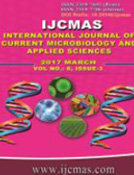


 National Academy of Agricultural Sciences (NAAS)
National Academy of Agricultural Sciences (NAAS)

|
PRINT ISSN : 2319-7692
Online ISSN : 2319-7706 Issues : 12 per year Publisher : Excellent Publishers Email : editorijcmas@gmail.com / submit@ijcmas.com Editor-in-chief: Dr.M.Prakash Index Copernicus ICV 2018: 95.39 NAAS RATING 2020: 5.38 |
Turcicum leaf blight (TLB) or Northern Corn Leaf Blight (NCLB) is a ubiquitous foliar disease of corn (maize) caused by Exserohilum turcicum, the anamorph of the ascomycete Setosphaeria. The TLB fungus survives through the winter on infected maize residue at the soil surface. As temperatures rise in the spring and early summer, the fungus produces spores on residue, and then the spores are splashed or wind-blown onto leaves of the new maize crop. Infection occurs during periods of moderate (64° to 81°F), wet and humid weather. The disease begins as long, slender, grayish or tan leaf lesions that run parallel to the mid vein. Lesions can eventually expand to a more oblong or “cigar” shape. Lesions may also form on husks. Loss of photosynthetic tissue can result in decreased yield, and silage quality can be affected. Effective management practices that reduce the impact of TLB include selecting resistant cultivars, reducing maize residue, timely planting and applying foliar fungicides.
 |
 |
 |
 |
 |